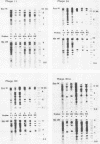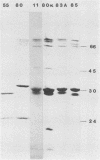Abstract
The typing bacteriophages 55, 80, 83A, and 85 of Staphylococcus aureus, representative of the three major lytic groups of serological group B aureophages, have been examined for relatedness of their genomes and virion proteins. Phages 11 and 80 alpha were also examined to determine the relationship of phage 80 alpha to phages 11 and 80. Total genome hybridization measurements divided the phages into two groups. Phages 55 and 80, in the first group, had DNA homology of 50%. Phages 11, 80 alpha, 83A, and 85 formed a second group with 27 to 65% homology. Homology between the two groups was in the range of 14 to 22%. Phage 80 alpha is more closely related to phage 11 than to phage 80, though it is probably not a simple recombinant of phages 11 and 80. Restriction enzyme digestion and phage [32P]DNA hybridization analysis of the endonuclease-generated fragments from each phage DNA confirmed the findings of the DNA homology measurements. The endonuclease fragment patterns generated by EcoRI and HindIII were distinctive for each phage, confirming that none of the phages are closely related. Common sequences were present in most fragments from the phage DNAs when the labeled probe DNA was from a different phage in the same group. Cross-group probing of endonuclease fragments revealed both a diminished level of homology when similar sequences were present and the probable absence of some sequences. Virion proteins, examined by polyacrylamide gel electrophoresis, were similar in number and molecular weight for phages 11, 80 alpha, 83A, and 85, reflecting the DNA homology analyses. The virion proteins from phages 55 and 80, however, were more distinctive, and both differed from the phages in the other group.
Full text
PDF





Images in this article
Selected References
These references are in PubMed. This may not be the complete list of references from this article.
- Botstein D. A theory of modular evolution for bacteriophages. Ann N Y Acad Sci. 1980;354:484–490. doi: 10.1111/j.1749-6632.1980.tb27987.x. [DOI] [PubMed] [Google Scholar]
- Cohen S., Sweeney H. M. Effect of the prophage and penicillinase plasmid of the recipient strain upon the transduction and the stability of methicillin resistance in Staphylococcus aureus. J Bacteriol. 1973 Nov;116(2):803–811. doi: 10.1128/jb.116.2.803-811.1973. [DOI] [PMC free article] [PubMed] [Google Scholar]
- Cowie D. B., Avery R. J., Champe S. P. DNA homology among the T-even bacteriophages. Virology. 1971 Jul;45(1):30–37. doi: 10.1016/0042-6822(71)90109-7. [DOI] [PubMed] [Google Scholar]
- Duval-Iflah Y., Van Heijenoort J., Rousseau M., Raibaud P. Lysogenic conversion for multiple characters in a strain of Staphylococcus aureus. J Bacteriol. 1977 Jun;130(3):1281–1291. doi: 10.1128/jb.130.3.1281-1291.1977. [DOI] [PMC free article] [PubMed] [Google Scholar]
- Frost A. J., Bradshaw E. The role of lysogeny in the modification of phage typing patterns of Staphylococcus aureus isolated from dairy cows. J Hyg (Lond) 1980 Oct;85(2):301–307. doi: 10.1017/s0022172400063348. [DOI] [PMC free article] [PubMed] [Google Scholar]
- Guidolin A., Morelli G., Kamke M., Manning P. A. Vibrio cholerae bacteriophage CP-T1: characterization of bacteriophage DNA and restriction analysis. J Virol. 1984 Jul;51(1):163–169. doi: 10.1128/jvi.51.1.163-169.1984. [DOI] [PMC free article] [PubMed] [Google Scholar]
- Jollick J. D. Evidence for bacteriophage conversion in Staphylococcus. Microbios. 1972 Sep-Oct;6(22):97–100. [PubMed] [Google Scholar]
- Kondo I., Fujise K. Serotype B staphylococcal bacteriophage singly converting staphylokinase. Infect Immun. 1977 Nov;18(2):266–272. doi: 10.1128/iai.18.2.266-272.1977. [DOI] [PMC free article] [PubMed] [Google Scholar]
- Lacey R. W. Evidence for two mechanisms of plasmid transfer in mixed cultures of Staphylococcus aureus. J Gen Microbiol. 1980 Aug;119(2):423–435. doi: 10.1099/00221287-119-2-423. [DOI] [PubMed] [Google Scholar]
- Laemmli U. K. Cleavage of structural proteins during the assembly of the head of bacteriophage T4. Nature. 1970 Aug 15;227(5259):680–685. doi: 10.1038/227680a0. [DOI] [PubMed] [Google Scholar]
- Mason R. E., Allen W. E. Characteristics of Staphylococcus aureus associated with lysogenic conversion to loss of beta-hemolysin production. Can J Microbiol. 1975 Jul;21(7):1113–1116. doi: 10.1139/m75-161. [DOI] [PubMed] [Google Scholar]
- NOVICK R. P. ANALYSIS BY TRANSDUCTION OF MUTATIONS AFFECTING PENICILLINASE FORMATION IN STAPHYLOCOCCUS AUREUS. J Gen Microbiol. 1963 Oct;33:121–136. doi: 10.1099/00221287-33-1-121. [DOI] [PubMed] [Google Scholar]
- Pariza M. W., Iandolo J. J. Base ratio and deoxyribonucleic acid homology studies of six Staphylococcus aureus typing bacteriophages. Appl Microbiol. 1974 Feb;27(2):317–323. doi: 10.1128/am.27.2.317-323.1974. [DOI] [PMC free article] [PubMed] [Google Scholar]
- ROSENBLUM E. D., TYRONE S. SEROLOGY, DENSITY, AND MORPHOLOGY OF STAPHYLOCOCCAL PHAGES. J Bacteriol. 1964 Dec;88:1737–1742. doi: 10.1128/jb.88.6.1737-1742.1964. [DOI] [PMC free article] [PubMed] [Google Scholar]
- ROSENDAL K., BUELOW P., JESSEN O. LYOGENIC CONVERSION IN STAPHYLOCOCCUS AUREUS, TO A CHANGE IN THE PRODUCTION OF EXTRACELLULAR "TWEEN"-SPLITTING ENZYME. Nature. 1964 Dec 19;204:1222–1223. doi: 10.1038/2041222b0. [DOI] [PubMed] [Google Scholar]
- Schaefler S. Bacteriophage-mediated acquisition of antibiotic resistance by Staphylococcus aureus type 88. Antimicrob Agents Chemother. 1982 Mar;21(3):460–467. doi: 10.1128/aac.21.3.460. [DOI] [PMC free article] [PubMed] [Google Scholar]
- Southern E. M. Detection of specific sequences among DNA fragments separated by gel electrophoresis. J Mol Biol. 1975 Nov 5;98(3):503–517. doi: 10.1016/s0022-2836(75)80083-0. [DOI] [PubMed] [Google Scholar]
- WENTWORTH B. B. BACTERIOPHAGE TYPING OF THE STAPHYLOCOCCI. Bacteriol Rev. 1963 Sep;27:253–272. doi: 10.1128/br.27.3.253-272.1963. [DOI] [PMC free article] [PubMed] [Google Scholar]





